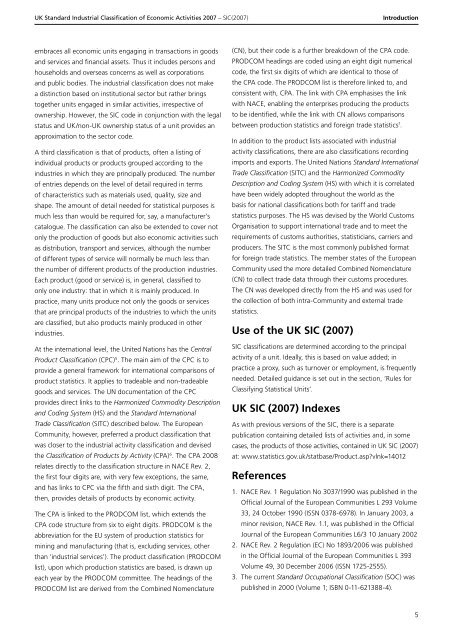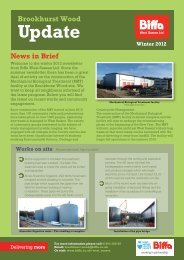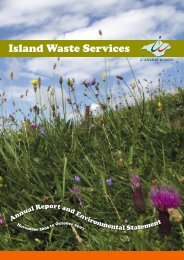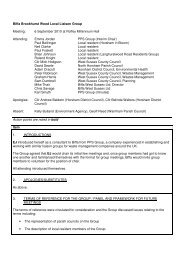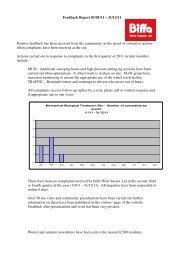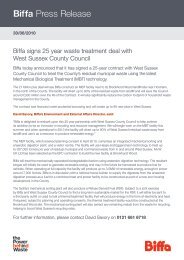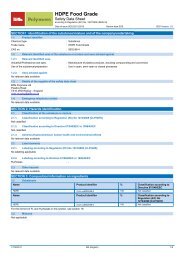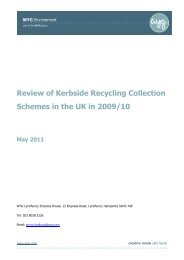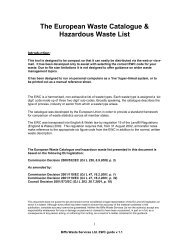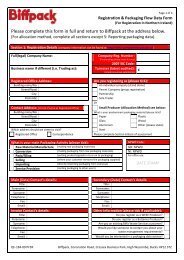detailed explanation for each SIC code - Biffa
detailed explanation for each SIC code - Biffa
detailed explanation for each SIC code - Biffa
You also want an ePaper? Increase the reach of your titles
YUMPU automatically turns print PDFs into web optimized ePapers that Google loves.
UK Standard Industrial Classification of Economic Activities 2007 – <strong>SIC</strong>(2007)<br />
Introduction<br />
embraces all economic units engaging in transactions in goods<br />
and services and financial assets. Thus it includes persons and<br />
households and overseas concerns as well as corporations<br />
and public bodies. The industrial classification does not make<br />
a distinction based on institutional sector but rather brings<br />
together units engaged in similar activities, irrespective of<br />
ownership. However, the <strong>SIC</strong> <strong>code</strong> in conjunction with the legal<br />
status and UK/non-UK ownership status of a unit provides an<br />
approximation to the sector <strong>code</strong>.<br />
A third classification is that of products, often a listing of<br />
individual products or products grouped according to the<br />
industries in which they are principally produced. The number<br />
of entries depends on the level of detail required in terms<br />
of characteristics such as materials used, quality, size and<br />
shape. The amount of detail needed <strong>for</strong> statistical purposes is<br />
much less than would be required <strong>for</strong>, say, a manufacturer’s<br />
catalogue. The classification can also be extended to cover not<br />
only the production of goods but also economic activities such<br />
as distribution, transport and services, although the number<br />
of different types of service will normally be much less than<br />
the number of different products of the production industries.<br />
Each product (good or service) is, in general, classified to<br />
only one industry: that in which it is mainly produced. In<br />
practice, many units produce not only the goods or services<br />
that are principal products of the industries to which the units<br />
are classified, but also products mainly produced in other<br />
industries.<br />
At the international level, the United Nations has the Central<br />
Product Classification (CPC) 5 . The main aim of the CPC is to<br />
provide a general framework <strong>for</strong> international comparisons of<br />
product statistics. It applies to tradeable and non-tradeable<br />
goods and services. The UN documentation of the CPC<br />
provides direct links to the Harmonized Commodity Description<br />
and Coding System (HS) and the Standard International<br />
Trade Classification (SITC) described below. The European<br />
Community, however, preferred a product classification that<br />
was closer to the industrial activity classification and devised<br />
the Classification of Products by Activity (CPA) 6 . The CPA 2008<br />
relates directly to the classification structure in NACE Rev. 2,<br />
the first four digits are, with very few exceptions, the same,<br />
and has links to CPC via the fifth and sixth digit. The CPA,<br />
then, provides details of products by economic activity.<br />
The CPA is linked to the PRODCOM list, which extends the<br />
CPA <strong>code</strong> structure from six to eight digits. PRODCOM is the<br />
abbreviation <strong>for</strong> the EU system of production statistics <strong>for</strong><br />
mining and manufacturing (that is, excluding services, other<br />
than ‘industrial services’). The product classification (PRODCOM<br />
list), upon which production statistics are based, is drawn up<br />
<strong>each</strong> year by the PRODCOM committee. The headings of the<br />
PRODCOM list are derived from the Combined Nomenclature<br />
(CN), but their <strong>code</strong> is a further breakdown of the CPA <strong>code</strong>.<br />
PRODCOM headings are <strong>code</strong>d using an eight digit numerical<br />
<strong>code</strong>, the first six digits of which are identical to those of<br />
the CPA <strong>code</strong>. The PRODCOM list is there<strong>for</strong>e linked to, and<br />
consistent with, CPA. The link with CPA emphasises the link<br />
with NACE, enabling the enterprises producing the products<br />
to be identified, while the link with CN allows comparisons<br />
between production statistics and <strong>for</strong>eign trade statistics 7 .<br />
In addition to the product lists associated with industrial<br />
activity classifications, there are also classifications recording<br />
imports and exports. The United Nations Standard International<br />
Trade Classification (SITC) and the Harmonized Commodity<br />
Description and Coding System (HS) with which it is correlated<br />
have been widely adopted throughout the world as the<br />
basis <strong>for</strong> national classifications both <strong>for</strong> tariff and trade<br />
statistics purposes. The HS was devised by the World Customs<br />
Organisation to support international trade and to meet the<br />
requirements of customs authorities, statisticians, carriers and<br />
producers. The SITC is the most commonly published <strong>for</strong>mat<br />
<strong>for</strong> <strong>for</strong>eign trade statistics. The member states of the European<br />
Community used the more <strong>detailed</strong> Combined Nomenclature<br />
(CN) to collect trade data through their customs procedures.<br />
The CN was developed directly from the HS and was used <strong>for</strong><br />
the collection of both intra-Community and external trade<br />
statistics.<br />
Use of the UK <strong>SIC</strong> (2007)<br />
<strong>SIC</strong> classifications are determined according to the principal<br />
activity of a unit. Ideally, this is based on value added; in<br />
practice a proxy, such as turnover or employment, is frequently<br />
needed. Detailed guidance is set out in the section, ‘Rules <strong>for</strong><br />
Classifying Statistical Units’.<br />
UK <strong>SIC</strong> (2007) Indexes<br />
As with previous versions of the <strong>SIC</strong>, there is a separate<br />
publication containing <strong>detailed</strong> lists of activities and, in some<br />
cases, the products of those activities, contained in UK <strong>SIC</strong> (2007)<br />
at: www.statistics.gov.uk/statbase/Product.asp?vlnk=14012<br />
References<br />
1. NACE Rev. 1 Regulation No 3037/1990 was published in the<br />
Official Journal of the European Communities L 293 Volume<br />
33, 24 October 1990 (ISSN 0378-6978). In January 2003, a<br />
minor revision, NACE Rev. 1.1, was published in the Official<br />
Journal of the European Communities L6/3 10 January 2002<br />
2. NACE Rev. 2 Regulation (EC) No 1893/2006 was published<br />
in the Official Journal of the European Communities L 393<br />
Volume 49, 30 December 2006 (ISSN 1725-2555).<br />
3. The current Standard Occupational Classification (SOC) was<br />
published in 2000 (Volume 1; ISBN 0-11-621388-4).<br />
5


